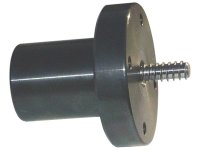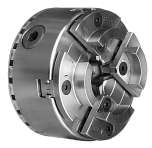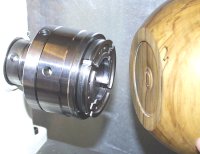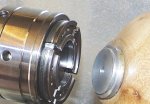Screw chuck
 A faceplate which has a single screw, fixed in position and projecting from
the exact centre of the face, is known as a "screw chuck". Sometimes they are supplied as a freebie with a multi chuck but it is better if you have an independent one. Screwchucks with a pointed small screw enable quick mounting of small blocks of wood - you can just screw the block on while the screwchuck is on the lathe. Screw chucks with larger parallel threaded screws require you to drill a pilot hole first but give a superior grip.
A faceplate which has a single screw, fixed in position and projecting from
the exact centre of the face, is known as a "screw chuck". Sometimes they are supplied as a freebie with a multi chuck but it is better if you have an independent one. Screwchucks with a pointed small screw enable quick mounting of small blocks of wood - you can just screw the block on while the screwchuck is on the lathe. Screw chucks with larger parallel threaded screws require you to drill a pilot hole first but give a superior grip.You can make servicable screw chucks yourself out of wood on your lathe! These are handy for holding such projects as wooden fruit, toy wheels or anything which can be held by a small central hole.

 Most turners nowadays think of a chuck as one of the modern "multi chucks" which
are supposed to grip just about anything. These complex and expensive devices
are very desirable - although not strictly essential. There is a bewildering
variety of multi purpose chucks available. Most of them can be classified as
either "collet chucks" or "scroll chucks". Collet chucks have only a limited
movement in the jaws, normally about 6mm change in diameter. This means that
the wood has to be accurately cut to fit into the chuck jaws. The chuck jaws
or "collets" are specially shaped with a hook or dovetail section to get a positive
grip on the wood. The special jaws are made to either expand into a prepared
recess in the wood or they contract over a "spigot" which again has to be prepared
on the end of the workpiece. Scroll chucks have the advantage of a much larger
jaw movement. This makes it much easier to prepare the wood to fit, because
less accuracy is needed. Scroll chucks are much more expensive to manufacture
than collet chucks and a good scroll chuck with a selection of dovetail jaws
can cost more than a lathe. Scroll chucks use the same mechanism as metal turning
chucks and have a powerful grip. A four jaw scroll chuck can grip some wood
blanks, particularly square section blanks without any preparation. The security
of grip in this case is only good enough for small projects because of the small contact
area but the saving in preparation time is sufficient to justify the extra cost
of this type of chuck to a professional turner.
Most turners nowadays think of a chuck as one of the modern "multi chucks" which
are supposed to grip just about anything. These complex and expensive devices
are very desirable - although not strictly essential. There is a bewildering
variety of multi purpose chucks available. Most of them can be classified as
either "collet chucks" or "scroll chucks". Collet chucks have only a limited
movement in the jaws, normally about 6mm change in diameter. This means that
the wood has to be accurately cut to fit into the chuck jaws. The chuck jaws
or "collets" are specially shaped with a hook or dovetail section to get a positive
grip on the wood. The special jaws are made to either expand into a prepared
recess in the wood or they contract over a "spigot" which again has to be prepared
on the end of the workpiece. Scroll chucks have the advantage of a much larger
jaw movement. This makes it much easier to prepare the wood to fit, because
less accuracy is needed. Scroll chucks are much more expensive to manufacture
than collet chucks and a good scroll chuck with a selection of dovetail jaws
can cost more than a lathe. Scroll chucks use the same mechanism as metal turning
chucks and have a powerful grip. A four jaw scroll chuck can grip some wood
blanks, particularly square section blanks without any preparation. The security
of grip in this case is only good enough for small projects because of the small contact
area but the saving in preparation time is sufficient to justify the extra cost
of this type of chuck to a professional turner. It is actually a four jaw self centering scroll chuck. The scroll is conical.
It is an example of a chuck which grips in either expansion or compression and
it also offers a valuable alternative to the need to prepare the wood to fit
the chuck - the chuck can be fitted with wooden jaws which are shaped to fit
the job! You often need to rechuck a workpiece to finish turn the part previously
held (and thus rendered inaccessible) by the chuck jaws. Home built wood jaw
sets are ideal for "second op. work" as they say in engineering. Quadrants of
scrap wood or plywood are screwed on to the face of the existing metal jaws.
The assembly is mounted on the lathe and the wood jaws turned to shape. They
can just as easily be re-shaped later for another job. The wood jaws can be
as simple or elaborate as the job demands and they can grip internally or externally.
If they are shaped while on the chuck they are bound to run true.
It is actually a four jaw self centering scroll chuck. The scroll is conical.
It is an example of a chuck which grips in either expansion or compression and
it also offers a valuable alternative to the need to prepare the wood to fit
the chuck - the chuck can be fitted with wooden jaws which are shaped to fit
the job! You often need to rechuck a workpiece to finish turn the part previously
held (and thus rendered inaccessible) by the chuck jaws. Home built wood jaw
sets are ideal for "second op. work" as they say in engineering. Quadrants of
scrap wood or plywood are screwed on to the face of the existing metal jaws.
The assembly is mounted on the lathe and the wood jaws turned to shape. They
can just as easily be re-shaped later for another job. The wood jaws can be
as simple or elaborate as the job demands and they can grip internally or externally.
If they are shaped while on the chuck they are bound to run true.
 This is a development of the above by Jack Cox. A metal disc is heated before
the hot melt glue is applied. This gives a very strong joint and the wood is ready to turn as soon as the glue cools. The aluminium disc is machined to fit the chuck jaws. When the project is finished
the disc is re-heated to release it, leaving a flat surface with no recess.
This is a development of the above by Jack Cox. A metal disc is heated before
the hot melt glue is applied. This gives a very strong joint and the wood is ready to turn as soon as the glue cools. The aluminium disc is machined to fit the chuck jaws. When the project is finished
the disc is re-heated to release it, leaving a flat surface with no recess.